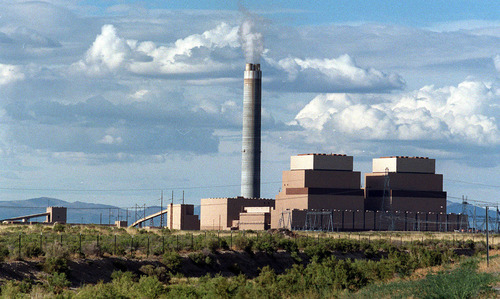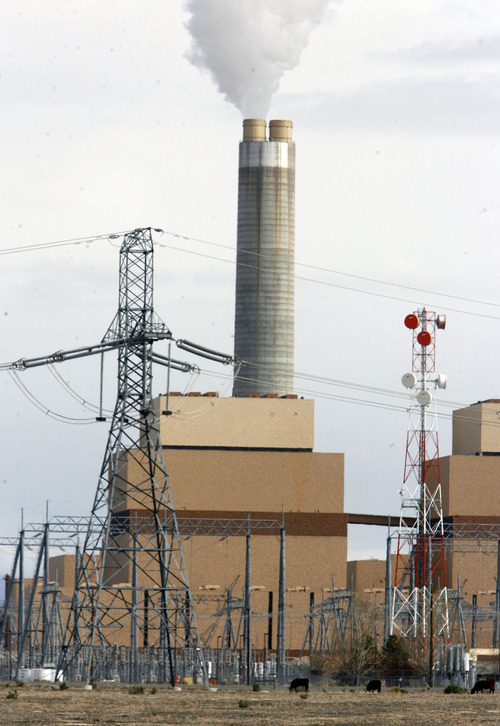This is an archived article that was published on sltrib.com in 2012, and information in the article may be outdated. It is provided only for personal research purposes and may not be reprinted.
A new national greenhouse gas inventory shows that Utah's power plants, like those nationwide, are the biggest contributors to the pollution blamed for climate change.
Sixty–one Utah facilities are included in the first-of-its-kind inventory of the large emitters. They release a total of nearly 42 million metric tons of greenhouse gases yearly into the environment, with about 83 percent coming from 14 power plants.
Two coal-fired Utah plants are ranked among the top 100 emitters: the Intermountain Power Plant near Delta and the Hunter facility in Castle Dale.
The data, based on 2010 reports, is part of the first nationwide greenhouse gas tally of "big emitters" — 6,700 facilities that produce 25,000 metric tons of carbon dioxide equivalent or more per year, emissions that amount to the same pollution that would be generated by burning 131 rail cars of coal, according to the U.S. Environmental Protection Agency, which compiled the data.
"Thanks to strong collaboration and feedback from industry, states and other organizations, today we have a transparent, powerful data resource available to the public," said Gina McCarthy, assistant administrator for EPA's Office of Air and Radiation.
"The GHG Reporting Program data provides a critical tool for businesses and other innovators to find cost- and fuel-saving efficiencies that reduce greenhouse gas emissions, and foster technologies to protect public health and the environment,"she said.
Greenhouse gases are blamed for disrupting the global climate and pumping additional energy into the climate system that scientists predict will mean severe drought and warming in the West.
In Utah, there have been two preliminary inventories made in the past few years, but they were based on projections rather than reports from the facilities emitting greenhouse gases.
Former Utah Gov. Jon Huntsman added Utah to the Western Climate Initiative, a group of U.S. states and Canadian provinces that partnered to develop controls for the pollution blamed for climate change. But that effort has collapsed in the past year and the formation of a new climate-change organization, North America 2050,is currently under way.
Sarah Wright, director of the advocacy group Utah Clean Energy, said that the inventory is a first step to understanding greenhouse gases in the state and, ultimately, to helping industry and consumers make smart energy decisions.
"It [the inventory] not only makes sense from the perspective of climate change, but it makes economic sense," she said. "There's a huge potential to reduce energy waste in our state and save homeowners and business on their energy bills."
Bill Barron, an independent candidate for the U.S. Senate and founder of the Utah chapter of the Citizens Climate Lobby, also praised the inventory.
"It helps us understand the issue," he said.
Barron's campaign highlights the importance of dealing with climate change through what is called the "fee-and-dividend" approach to reducing greenhouse gases.
Environmental groups applauded EPA's move, which allows users to learn what facilities are emitting greenhouse gases even on a local level.
"Americans have a right to know about the pollution in their air," said Environmental Defense Fund Attorney Peter Zalzal. "This greenhouse gas emissions data promotes transparency and provides a strong foundation for Americans to work together in deploying smart climate policies."
fahys@sltrib.com
Twitter: @judyfutah —
EPA's national emissions inventory facts
Overall releases for industry's biggest emitters were roughly 3.2 billion metric tons of carbon dioxide equivalent.
Power plants were the largest stationary sources of direct emissions with 2,324 million metric tons of carbon dioxide equivalent, followed by petroleum refineries with emissions of 183 metric tons.
CO2 accounted for the largest share of direct greenhouse gas emissions with 95 percent, followed by methane with 4 percent, and nitrous oxide and fluorinated gases accounting for the other 1 percent.
100 facilities each reported emissions over 7 million metric tons, including 96 power plants, two iron and steel mills and two refineries. The Intermountain Power Plant in Delta, 12 million, and the Hunter power plant in Castle Dale, 9 million, are on that top 100 list.





